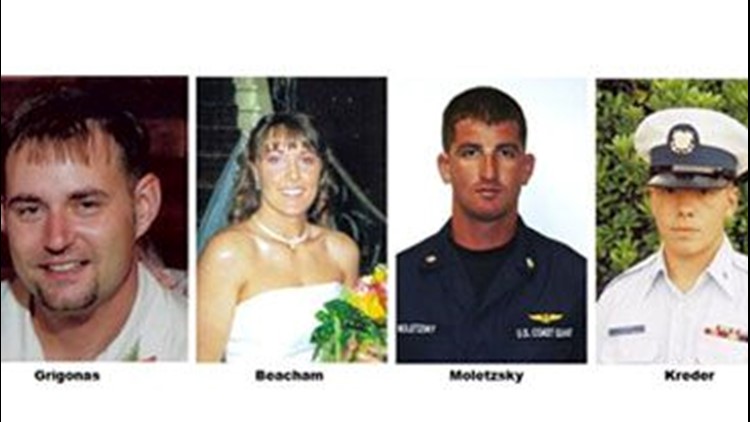SAN DIEGO (AP) - Investigators are meeting to look into the cause of a crash between a Coast Guard plane and a Marine helicopter that killed nine people off the Southern California coast.
The search for bodies and wreckage continues.
Coast Guard Lt. Josh Nelson says searchers will also try to locate the aircraft black box recorders. He won't speculate on the chances of recovering anything in an area where the water is more than 2,000 feet deep.
The crash Thursday evening involved a Coast Guard C-130 searching for a missing boater and a Marine Corps Super Cobra helicopter on a training mission. Debris was later found about 50 miles off of San Diego.
Nelson says a crash analysis board will look at the debris, radio transmissions from the plane pilots and other material.
This is an update to the story below.
LOS ANGELES (AP) - The search for nine people missing when a U.S. Coast Guard plane collided with a Marine Corps helicopter over the Pacific Ocean is now a recovery mission, officials said Sunday.
Petty Officer First Class Allison Conroy said there was little chance of finding survivors among the seven military personnel aboard the Coast Guard C-130 and the two in the Marine Corps AH-1W Super Cobra helicopter.
"We always hold out some hope, but at this point the Coast Guard has suspended the active search for survivors," Conroy said.
The two aircraft collided Thursday evening as the Coast Guard was searching for a missing boater. The Marine helicopter was flying in formation with another Cobra helicopter and two transports on a nighttime training exercise.
The Coast Guard has begun its investigation into the cause of the crash, Conroy said.
Kenneth Claiborne, the father of one of the missing crew members on the plane, said Sunday that his son, Marine 1st Lt. Thomas Claiborne, had been declared deceased. He declined to comment further and referred calls to a Marine spokesperson.
But the mother of Lt. Adam W. Bryant, 28, of Crewe, Va., who was a co-pilot on the Coast Guard plane, said she hadn't given up hope despite the Coast Guard's announcement.
"Miracles do happen," Nina Bryant said Sunday. "Miracles every day."
Rear Adm. Joseph Castillo said Saturday evening that the chance for finding survivors would be slim, even though the servicemembers had access to heat-retaining drysuits and were in excellent physical shape. Water temperatures were in the low 60s at the time of the collision.
"We don't ever want to suspend the case prematurely, when there may be someone out there," Castillo had said. "But hope gets less every day. My hope today is not what it was yesterday."
The Coast Guard search for the missing boater, David Jines, 50, was called off Saturday evening.
Nine aircraft searched over a 644-square-mile patch of ocean in waters about 2,000 feet deep. Debris from both aircraft was found, but there was no sign of the crew members.
All seven aboard the Coast Guard plane are stationed at the Coast Guard Air Station in Sacramento, Calif. Among the other missing crew members on the plane were Lt. Cmdr. Che Barnes, 35, of Capay, Calif.; Chief Petty Officer John F. Seidman, 43, of Carmichael, Calif.; Petty Officer 2nd Class Carl P. Grigonis, 35, of Mayfield Heights, Ohio; Petty Officer 2nd Class Monica L. Beacham, 29, of Decaturville, Tenn.; Petty Officer 2nd Class Jason S. Moletzsky, 26, of Norristown, Pa., and Petty Officer 3rd Class Danny R. Kreder II, 22, of Elm Mott, Texas.
Maj. Samuel Leigh, 35, of Belgrade, Maine, was the other crew member on board the Marine Corps helicopter.
"These brave men and women dedicated their lives to ensuring our safety, and today we are tragically reminded of the dangers they face while protecting our state and nation," California Gov. Arnold Schwarzenegger said in a statement Sunday. "Maria and I join all Californians in expressing our respect and gratitude for their service and sadness over their deaths."
The investigation will be conducted jointly by the Coast Guard and the Marine Corps, Petty Officer Henry Dunphy said Sunday. The Federal Aviation Administration and the National Transportation Safety Board will be available in a support role, Dunphy said.
The accident happened in airspace uncontrolled by the FAA and inside a so-called military warning area, which is at times open to civilian aircraft and at times closed for military use, FAA spokesman Ian Gregor said. He did not know the status of the airspace at the time of the crash.
Minutes before the collision, the FAA told the C-130 pilot to begin communicating with military controllers at Naval Air Station North Island in San Diego Bay, but it was not known if the pilot did so, Gregor said.
On Saturday, a top Coast Guard official said he believed the C-130 pilot had spoken with the military controllers before the accident.
Accident investigators who began arriving in San Diego on Saturday would review communications between the pilots and between the pilots and the FAA and military controllers, said Capt. Tom Farris, commander of the Coast Guard's 11th District.
Investigators are also collecting witness statements from those aboard the three other Marine aircraft and will check to see if any distress calls were made.
Calls to Marine Corps investigators were not immediately returned Sunday.
The Coast Guard C-130 is a four-engine turboprop transport aircraft. It generally carries a crew of five: two pilots, a navigator, flight engineer and loadmaster. The Coast Guard uses the C-130 for search and rescue missions and cargo and personnel transport.
The AH-1 SuperCobra is a twin-engine attack helicopter outfitted with a 20mm cannon that carries a pilot and co-pilot or gunner. The Marines use it for support of ground troops and protection of Navy ships and planes at sea.
___
Associated Press Writers Tim Huber in Charleston, W.Va., and Kristen Wyatt in Denver also contributed to this report.
Copyright 2009 The Associated Press.



